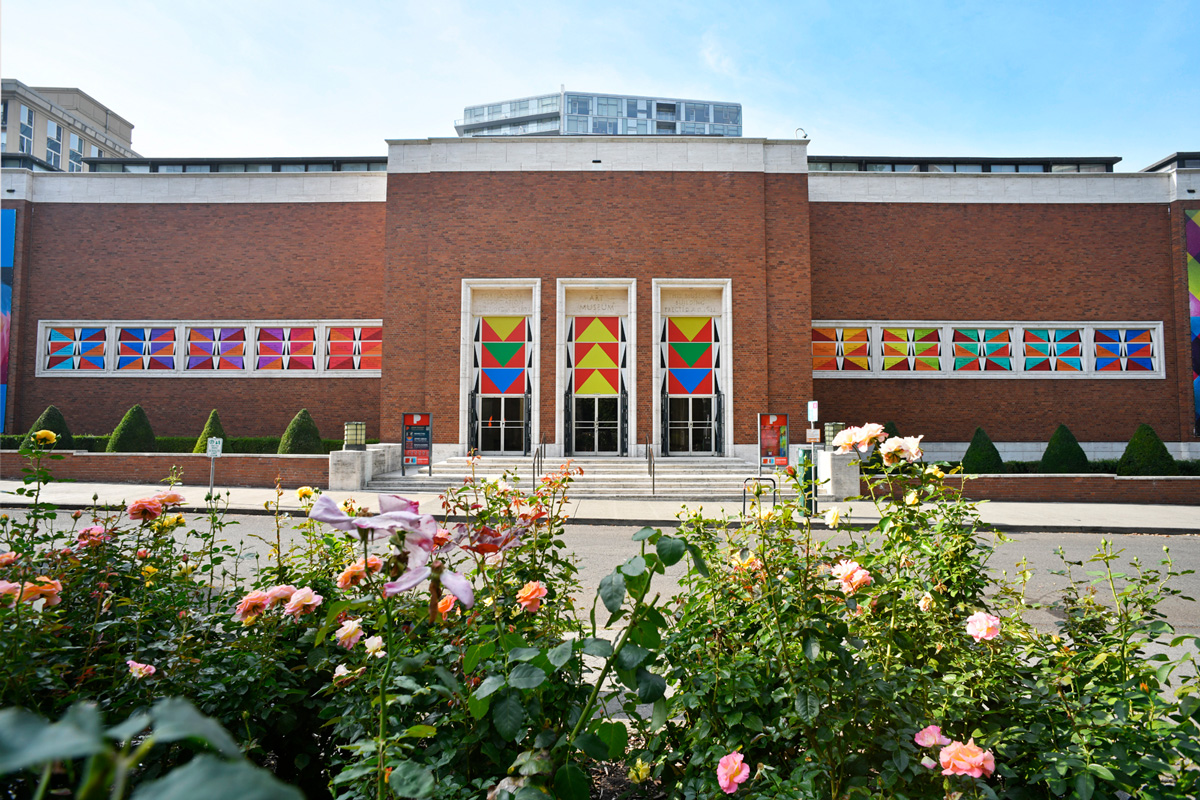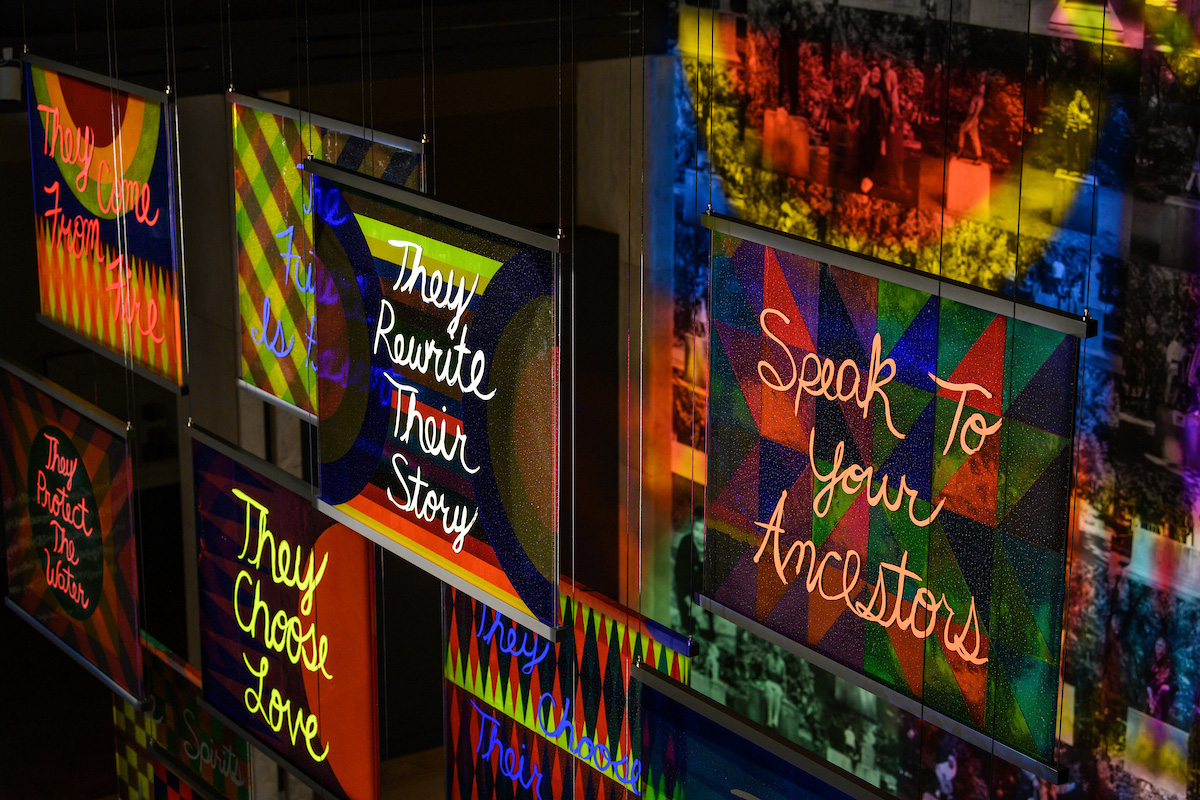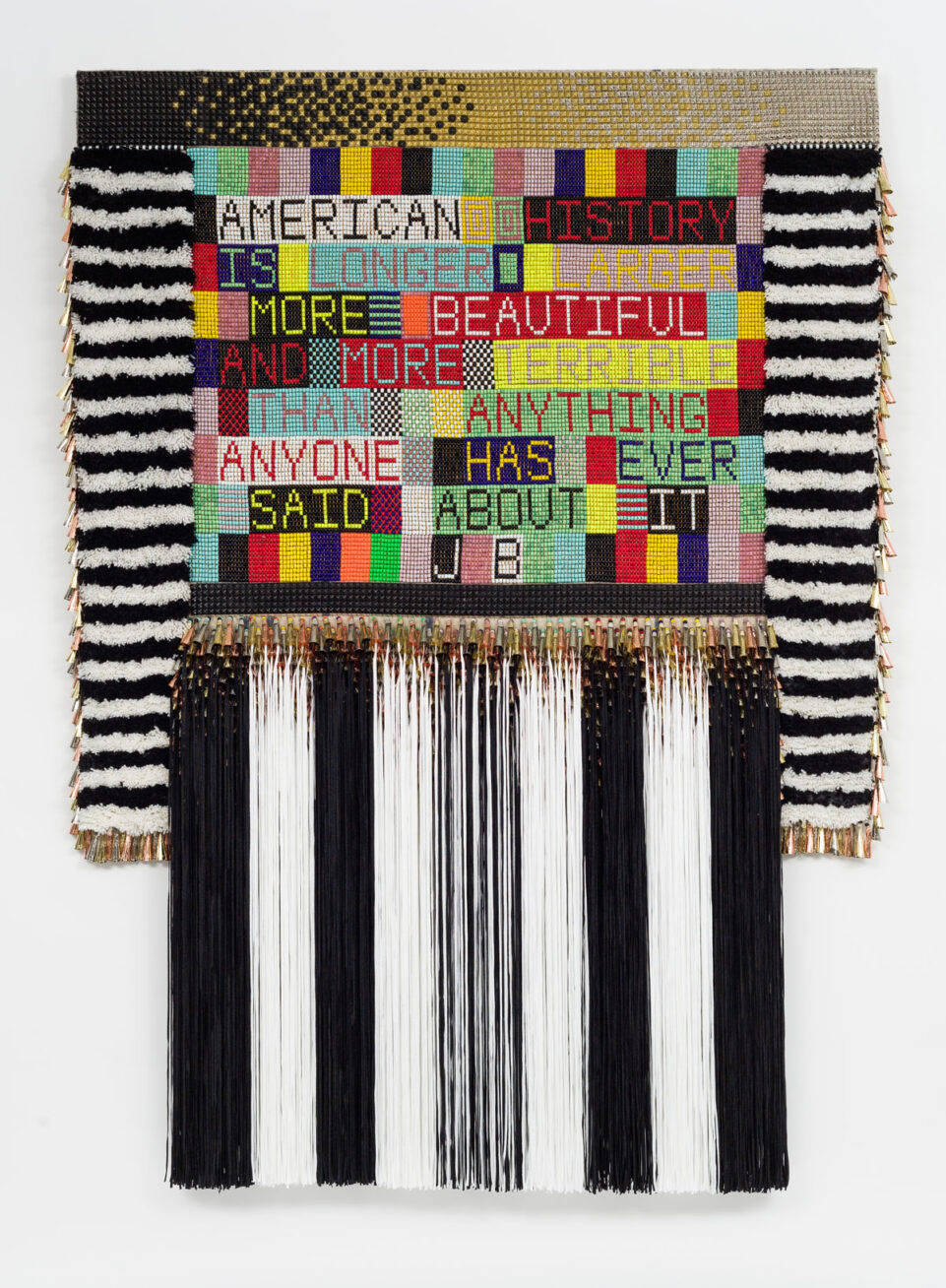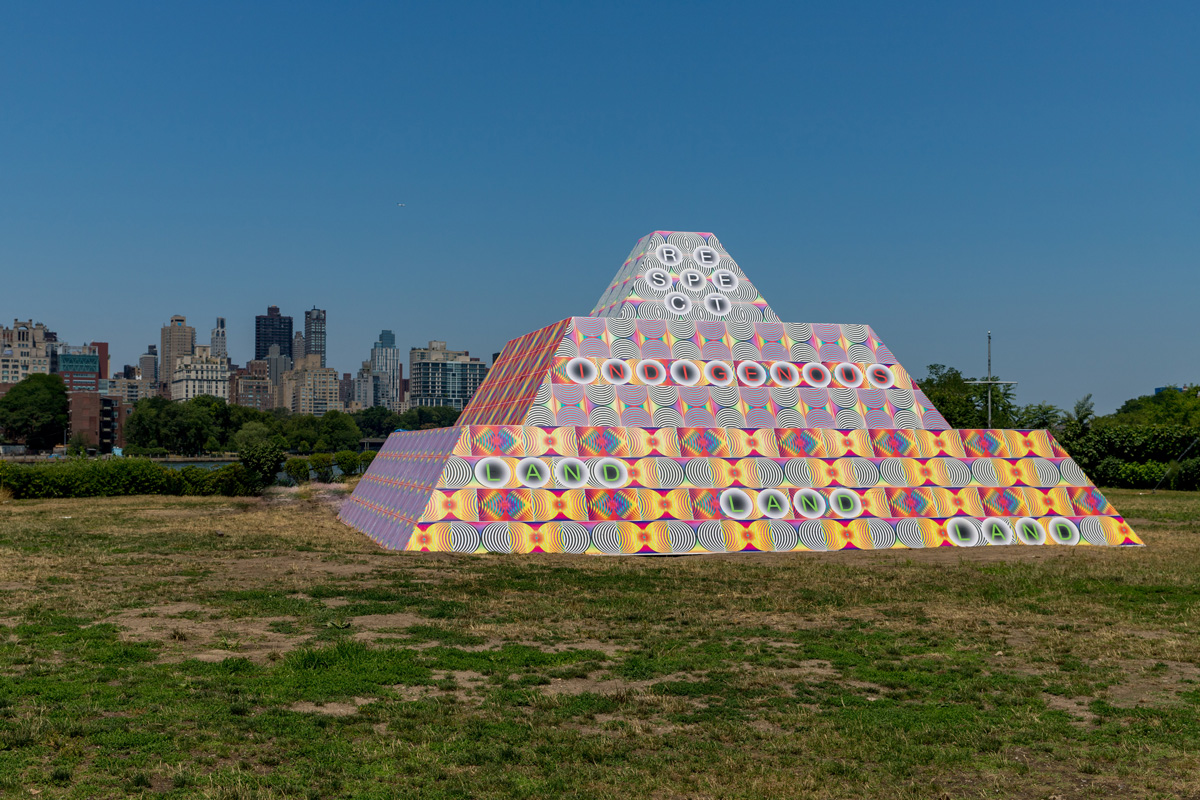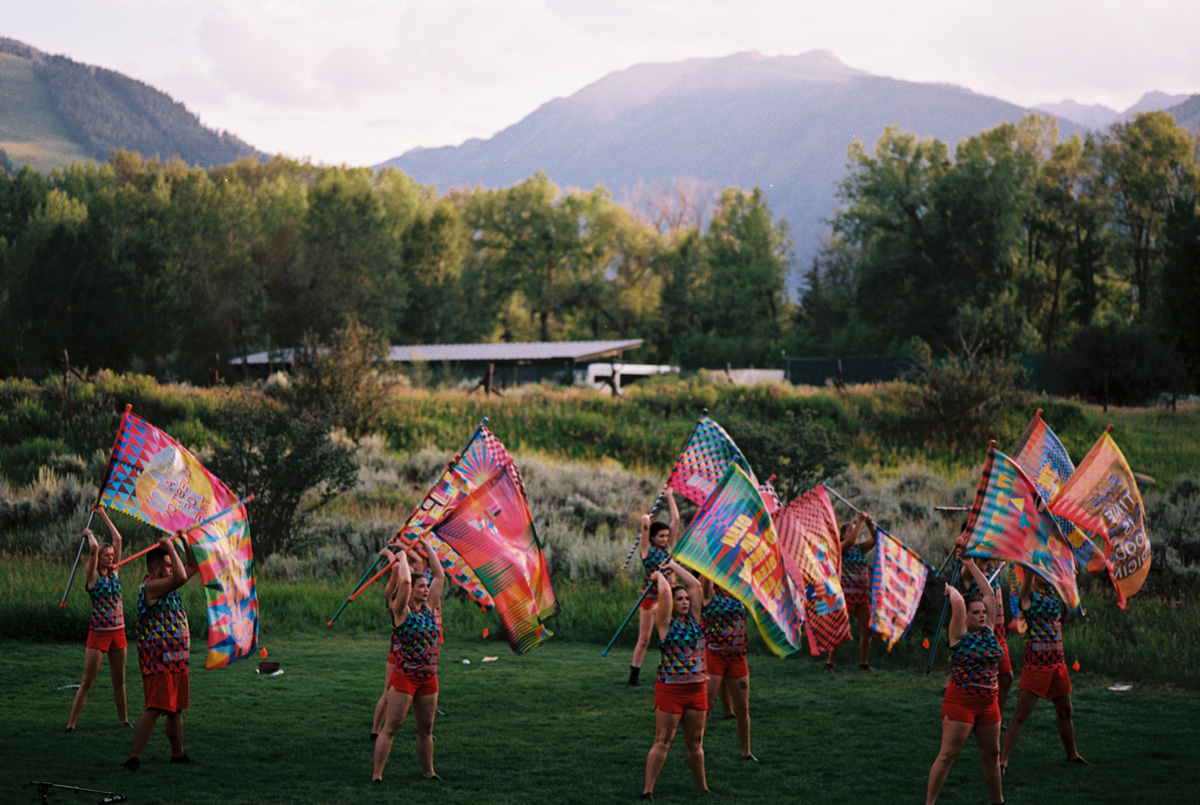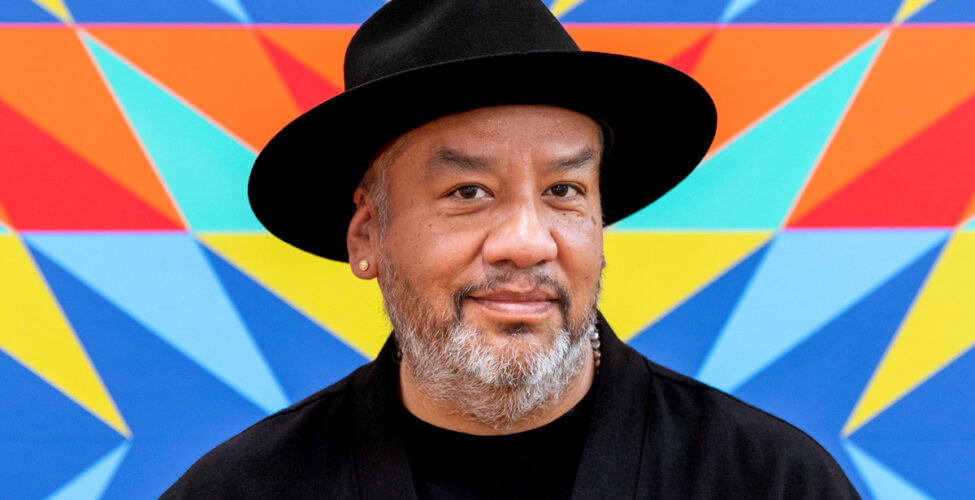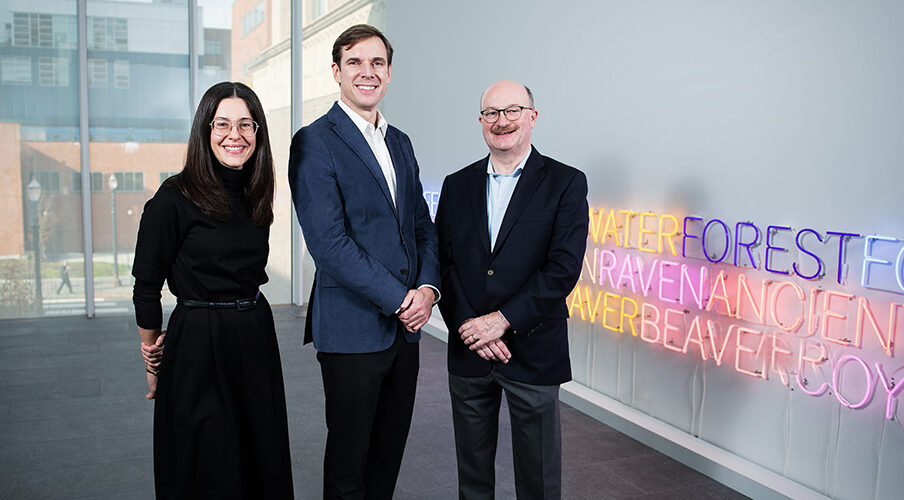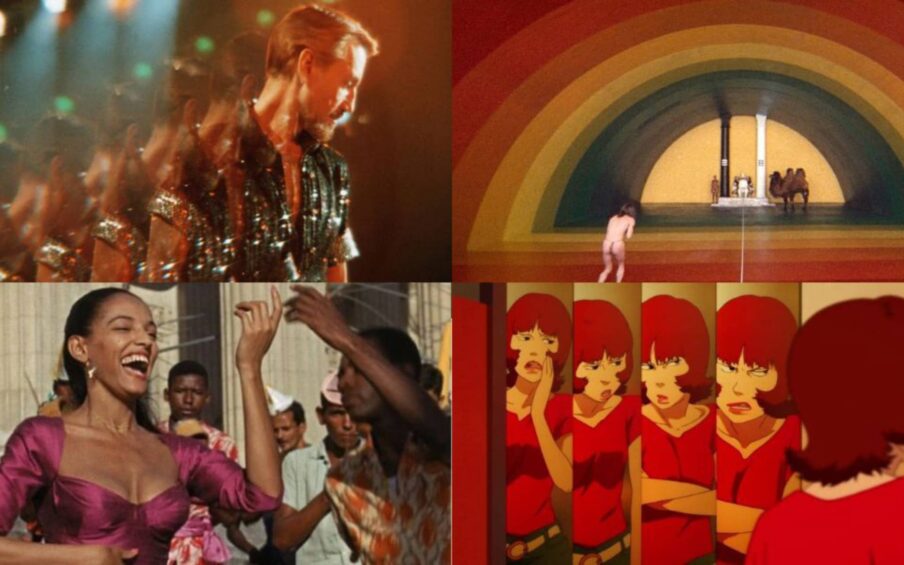U.S. Pavilion presented by Portland Art Museum and SITE Santa Fe
Co-Commissioned by Kathleen Ash-Milby, Louis Grachos, and Abigail Winograd
Portland Art Museum in Oregon and SITE Santa Fe in New Mexico, in cooperation with the U.S. Department of State’s Bureau of Educational and Cultural Affairs, announced today that Jeffrey Gibson will represent the United States at La Biennale di Venezia, the 60th International Art Exhibition. Celebrated for an artistic practice that combines American, Indigenous, and Queer histories with influences from music and pop culture, Gibson creates a dynamic visual language that reflects the inherent diversity and hybridity of American culture. Using abundant color, complex pattern, and text, he invites deep reflection on identity, inspires empathy, and advocates for a widening of access to democracy and freedom for all. On view April 20 through November 24, 2024, the Biennale provides international audiences with the first major opportunity to experience Gibson’s work outside of the U.S.
The 2024 U.S. Pavilion is co-commissioned by Kathleen Ash-Milby, Curator of Native American Art at the Portland Art Museum and a member of the Navajo Nation, Louis Grachos, Phillips Executive Director of SITE Santa Fe, and Abigail Winograd, independent curator, and is co-curated by Ash-Milby and Winograd. A member of the Mississippi Band of Choctaw Indians and of Cherokee descent, Gibson will be the first Indigenous artist to have a solo exhibition for the U.S. Pavilion. This exhibition is also the first to be co-commissioned and co-curated by a Native American curator.
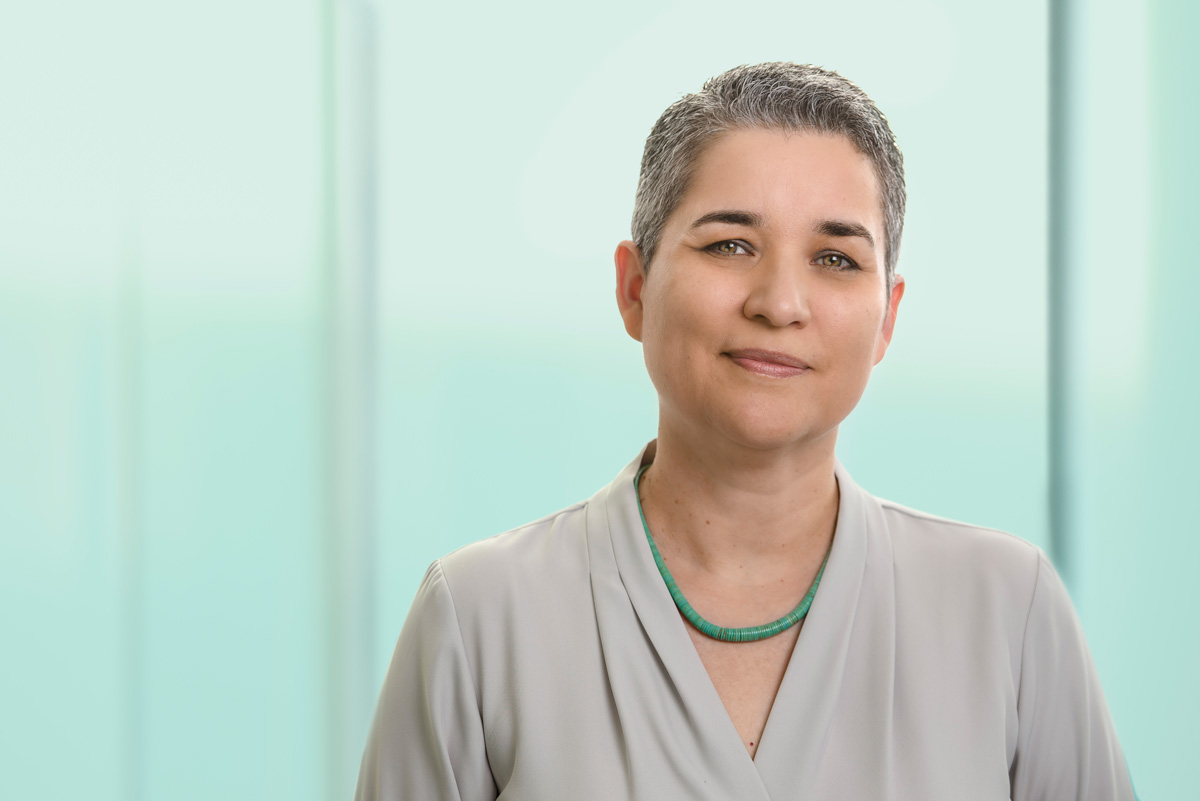
“Throughout his career, Jeffrey has challenged us to look at the world differently through his innovative and vibrant work,” said Ash-Milby. “His inclusive and collaborative approach is a powerful commentary on the influence and persistence of Native American cultures within the United States and globally, making him the ideal representative for the United States at this moment.”
“Having recently collaborated with Jeffrey to present a solo exhibition in Santa Fe, we are honored to continue championing his dynamic, insightful, and timely work—now on an international stage,” said Grachos. “This collaboration builds upon SITE Santa Fe’s long history as a platform for artistic innovation, providing artists with the support and resources they need to realize bold and ambitious visions.”
“I have long believed in the ability of Jeffrey’s work to be a force for positive change and to create the possibility of a radically inclusive future,” said Winograd. “It is my hope that as a global audience experiences his work through the Biennale, they will also find it to be a source of joy and healing, something sorely needed in a world driven by conflict and crisis. I couldn’t be more thrilled to be working with Jeffrey and this team to share his work more broadly.”
“Jeffrey’s work embodies the aspirations of the Portland Art Museum’s program to reveal the beauty and complexities of the world, and creates a deeper understanding of our shared humanity,” said Brian Ferriso, Director of the Portland Art Museum. “We are incredibly honored to help bring his vision to an international audience through this presentation at the Venice Biennale.”
For the U.S. Pavilion, Gibson will activate the interior and exterior of the U.S. Pavilion with a series of new and recent works that invite reflection on individual and collective identities including sculpture, paintings, multimedia works and a site-specific installation activating the pavilion’s courtyard. In conjunction with the presentation at the U.S. Pavilion and in partnerships with the Institute of American Indian Arts (Santa Fe, NM) and Bard College (Annandale-on-Hudson, NY), Portland and SITE will also develop year-long educational programming. They will focus on connecting Indigenous, Native American and international undergraduate humanities students and graduate art students, including bringing students from the Institute of American Indian Arts to Venice for a summer arts program and organizing a fall 2024 convening for students, scholars, and the public.
The 2024 U.S. Pavilion: Jeffrey Gibson is made possible by The Bureau of Educational and Cultural Affairs of the U.S. Department of State.
About the artist
Jeffrey Gibson (b. 1972, Colorado Springs, CO) is a member of the Mississippi Band of Choctaw Indians and of Cherokee descent who currently lives and works near Hudson, NY. Gibson’s approach to art-making is defined by its hybrid and cosmopolitan nature, largely informed by his international upbringing in the U.S., Korea, and Germany. During his itinerant childhood as the son of a retired civil employee of the U.S. Army, he found solace and friendship in the world of music, at various times exploring the sounds and social traditions of the punk and rave music of his generation, and in the powwow traditions of his intertribal Native heritage. Resisting static, preconceived notions of what people believe Native American art looks like, he combines Native art traditions with the visual languages of modernism to explore the confluence of personal identity, culture, history, and international social narratives.
Recent solo exhibitions include This Burning World: Jeffrey Gibson (ICA San Francisco, 2022), Jeffrey Gibson: The Body Electric (SITE Santa Fe, 2022), Jeffrey Gibson: They Come From Fire (Portland Art Museum, 2022), Jeffrey Gibson: INFINITE INDIGENOUS QUEER LOVE (deCordova Sculpture Park and Museum, 2022) and Jeffrey Gibson: Like A Hammer (Denver Art Museum, 2018). His work is included in many permanent collections, including the Museum of Modern Art, Whitney Museum of American Art, Museum of Fine Arts Boston, Smithsonian National Museum of the American Indian, National Gallery of Canada, and Crystal Bridges Museum of American Art. His recently published book, AnIndigenous Present (August 2023), showcases diverse approaches to Indigenous concepts, forms and mediums by North American Indigenous contemporary artists, musicians, filmmakers, choreographers, architects, writers, photographers, and designers.
Gibson has been recognized with numerous awards, including a 2019 MacArthur Foundation Fellowship and he is currently an artist-in-residence at Bard College. Gibson received a Bachelor of Fine Arts in painting from the School of the Art Institute of Chicago in 1995 and his Master of Arts in painting from the Royal College of Art, London, in 1998.
About the co-commissioners/co-curators
Kathleen Ash-Milby
Kathleen Ash-Milby was appointed the Curator of Native American Art at the Portland Art Museum in 2019. Previously, as an Associate Curator at the Smithsonian National Museum of the American Indian in New York, she organized numerous solo and thematic group exhibitions of Native art in diverse media including Dakota Modern: The Art of Oscar Howe; Transformer: Native Art in Light and Sound; and Kay WalkingStick: An American Artist. International projects include SITElines Biennial: much wider than a line, at SITE Santa Fe; Mind (the) Gap: International Indigenous Art in Motion, Samstag Museum of Art, Adelaide, Australia; and Edgar Heap of Birds: Most Serene Republics, a collateral project for the 52nd International Art Exhibition of La Biennale di Venezia (2007). From 2001 to 2005, she was curator and co-director of the American Indian Community House Gallery in New York City. Recent publications include essays in Art in America, Art Journal, and Joseph Yoakum: What I Saw (2021) and The Routledge Companion to Indigenous Art Histories in the United States and Canada (2023). Ash-Milby is a recipient of two Secretary of the Smithsonian’s Excellence in Research awards and was a fellow in the Center for Curatorial Leadership Program in New York. A member of the Navajo Nation, she earned her Master of Arts from the University of New Mexico in Native American art history.
Louis Grachos
Louis Grachos became the Phillips Executive Director of SITE Santa Fe in 2021, having previously served as SITE’s Director from 1996 to 2003. During that time, Grachos oversaw the 1997 ground-breaking presentation of Robert Colescott as the first Black artist to represent the United States in a single-artist exhibition at the 47th International Art Exhibition of La Biennale di Venezia, curated by Miriam Roberts. Prior to his reappointment, he served for two years as the CEO and JoAnn McGrath Executive Director of the Palm Springs Art Museum. From 2013 to 2019, he was the Ernest and Sarah Butler Executive Director and CEO of The Contemporary Austin, where he expanded the museum’s curatorial and public programs, presenting the work of emerging and established artists such as Ai Weiwei, Janine Antoni, Carol Bove, Tom Friedman, Wangechi Mutu, Do Ho Suh, and SUPERFLEX, among many others. He also led several critical construction projects and capital campaigns, launched an international program of contemporary outdoor sculpture at the Betty and Edward Marcus Sculpture Park, and established the Suzanne Deal Booth / FLAG Art Foundation Prize for contemporary artists. From 2003 to 2012, Grachos served as the Executive Director of the Albright-Knox Art Gallery, now renamed the Buffalo AKG Art Museum; in that capacity, he stewarded one of the most prestigious museum collections of 20th century and contemporary art in the United States.
Abigail Winograd
Abigail Winograd is an independent curator and writer. Until April 2023 she was Curator-at-large and MacArthur Fellows Program Fortieth Anniversary Exhibition Curator at the Gray Center for the Arts and Inquiry, a role she originated at the Smart Museum of Art. In that role, she curated Toward Common Cause: Art, Social Change, and the MacArthur Fellows at 40, a city-wide, multi-venue exhibition of 29 artists, including Gibson (2021-2022). She also recently collaborated with Gibson on their co-edited monograph Jeffrey Gibson: Beyond the Horizon (2022) which examined his complex relationship to the depiction of Indigenous people, the history of Native American portraiture, and the institutions that frequently house such depictions. Her scholarly work has focused on the emergence of aberrant abstractions and institutional approaches to expanding canonical histories. She has held positions at the Frans Hals Museum in Haarlem, the Netherlands; Museum of Contemporary Art Chicago; Hirshhorn Museum and Sculpture Garden; Blanton Museum of Art; and Art Institute of Chicago. Winograd has contributed to books and museum catalogs, published academic articles, and written for publications such as Bomb, Mousse Magazine, Frieze, and Artforum. She received a Master’s and Ph.D. in Art History from the University of Texas at Austin and has additional degrees from Northwestern University and the University of Wisconsin-Madison.
About Portland Art Museum
Among the oldest museums in the United States, the Portland Art Museum is internationally recognized for its permanent collection and ambitious special exhibitions. Based in Portland, Oregon and distinguished for its longstanding commitment to showcasing the broad spectrum of Native American art, its holdings also include renowned collections of Asian and graphic arts. With a diverse program that includes PAM CUT // Center for an Untold Tomorrow, which expands the reach of cinema as an art form, the Museum is dedicated to creating opportunities for artists and access to art for the enrichment of our many audiences and diverse communities. The Museum strives to be an inclusive, accessible institution that facilitates respectful dialogue and the free exchange of ideas through art within its campus of landmark buildings, a cornerstone of Portland’s cultural district, and through its forthcoming expansion and renovation project that includes the construction of the Mark Rothko Pavilion (slated opening mid-2025). portlandartmuseum.org
About SITE Santa Fe
Guided by artists, rooted in New Mexico, SITE SANTA FE celebrates contemporary creative expression. SITE SANTA FE aspires to be an internationally recognized destination for art and artists and a community resource for creativity and learning. Founded in 1995 to establish the first international contemporary art biennial in the United States, SITE SANTA FE is a non-collecting art institution committed to supporting new developments in contemporary art, encouraging artistic exploration, and expanding traditional museum experiences. Since its launch, SITE SANTA FE has presented 11 international biennials, more than 100 contemporary art exhibitions, and works by hundreds of emerging and established artists from around the world and right here in New Mexico. SITE SANTA FE also presents a wide range of public and educational programs that include conversations with artists and curators, performances, film screenings, concerts, hands-on workshops, and collaborations with dozens of local schools and community organizations. sitesantafe.org
About La Biennale di Venezia
Established in 1895, the Venice Biennale is considered the most prestigious international art exhibition, introducing hundreds of thousands of visitors to exciting new art every two years. The 60th International Art Exhibition of La Biennale di Venezia (April 20 – November 24, 2024) will be curated by Adriano Pedrosa.
The United States Pavilion at the Giardini della Biennale, a building in the neoclassical style, opened on May 4, 1930. Since 1986, The U.S. Pavilion has been owned by the Solomon R. Guggenheim Foundation and managed by the Peggy Guggenheim Collection in Venice, which works closely with the Department of State and exhibition curators to install and maintain all official U.S. exhibitions presented in the Pavilion. Every two years, museum curators from across the U.S. detail their visions for the U.S. Pavilion in proposals that are reviewed by the NEA Federal Advisory Committee on International Exhibitions (FACIE), a group comprising curators, museum directors, and artists who then submit their recommendations to the U.S. Department of State’s Bureau of Educational and Cultural Affairs.
The United States Department of State’s Bureau of Educational and Cultural Affairs supports and manages official U.S. participation at the International Architecture Exhibitions of La Biennale di Venezia. The U.S. Department of State’s Bureau of Educational and Cultural Affairs (ECA) builds relations between the people of the United States and the people of other countries through academic, cultural, sports, professional, and private exchanges, as well as public-private partnerships and mentoring programs. These exchange programs improve foreign relations and strengthen the national security of the United States, support U.S. international leadership, and provide a broad range of domestic benefits by helping break down barriers that often divide us, like religion, politics, language and ethnicity, and geography. ECA programs build connections that engage and empower people and motivate them to become leaders and thinkers, to develop new skills, and to find connections that will create positive change in their communities. For more information, please visit https://exchanges.state.gov/us
Jeffrey Gibson: Selected work
